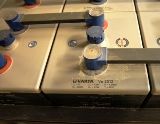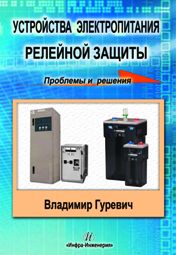Power supplies for relay protection: problems and solutions
 "Infra-engineering" publishing house released a new book by V.I. Gurevich, which is called "Power Supplies for Relay Protection: Problems and Solutions."
"Infra-engineering" publishing house released a new book by V.I. Gurevich, which is called "Power Supplies for Relay Protection: Problems and Solutions."
The book discusses the device, principle of operation and problems: secondary power supplies of microprocessor relay protection devices, storage batteries, charging and recharging devices, uninterruptible power sources, backup devices for DC systems. The problems of insulation management in DC systems, the problems of monitoring the integrity of the substation battery circuit, the problems of voltage drops and methods of dealing with them, as well as many other issues arising in the practice of operating systems for operating currents and auxiliary needs of substations and power plants are also considered.
To facilitate the understanding of the text, power engineers who work with the described electronic equipment, but are not experts in the field of electronics, provide a detailed description of the device and the principles of operation of transistors, thyristors, optocouplers, relays.
Foreword to the book "Relay Power Protection Devices: Problems and Solutions":

The RP power supply system starts from the auxiliary transformer of the substation and ends with the on-board power supply for the MPD, including the operating current system, chargers and chargers, storage batteries, uninterruptible power sources, auxiliary systems for monitoring the isolation and integrity of the operating circuits system.
All these devices and systems are interconnected with many connections and represent an integral organism, in which a breakdown in the work of one organ can lead to a serious "disease" of the entire organism. So, for example, the routine work of finding the place of the damaged insulation in the 230V DC network using a standard device, which was performed more than once and was well known to the electrical engineer, suddenly turns out to be the disconnection of a 220 kV transformer and a number of 220 kV overhead lines, redistribution of loads to other lines, their overloading and eventually to the collapse of the power system. Why?
Or here's another problem: while working on one of the substations in a DC system that must be completely isolated from the ground, an electrician accidentally grounded one of the poles.As a result, the internal power supplies of dozens of MPDs fail. Again the question is: why? A simpler situation: you need to choose a storage battery for the substation. One supplier offers GroE batteries, the other OGi and both advertise their products, and according to the submissions both types are equal.
How to properly navigate this situation? How to choose the right charging and charging device if you do not know what they are and how they differ from each other? Does this rig need the active harmonic filter highly recommended by the equipment vendor as a panacea for all ills? Is the uninterruptible power supply so bad that it distorts the consumed mains current so that the current harmonic distortion level reaches 40%?
The answers to all these questions are quite complex and require a certain level of knowledge among the personnel involved in the maintenance and operation of the current systems in operation. The lack of such knowledge or its absence not only prevents the maintenance of relay power systems at the correct level, but also sometimes serves as a source of severe damage to networks.
The new book by V. I. Gurevich describes in detail the devices and power supply systems for relay protection: from built-in power supplies for MPDs, charging and recharging devices, storage batteries, sources of uninterruptible power supply, to the characteristics of backup systems for working direct current of substations and power plants . The specific problems of relay protection devices and power systems encountered in practice but little known and not described in the technical literature due to their "obscurity" are also considered.
Knowing how to solve problems is just as important. Therefore, the description of technical problems is accompanied by proposals for their solution and proposed ways to solve these problems. Along the way, the author tried to solve the problem of the lack of knowledge in the field of electronics among the personnel servicing the power supply systems of the Russian Federation, which significantly complicates their daily work with the equipment. The author tried to solve this problem by describing in the first chapter of the book the basics of electronics and the most common element base: transistors, thyristors, optrons, logic elements, relays.
The book is intended for engineers and technicians engaged in the operation of operating current systems and auxiliary needs of substations and power plants, relay protection systems, and can also be useful for teachers and students of the relevant disciplines of secondary and higher educational institutions.
